Published on April 14, 2025 5:43 PM GMT
Previous posts (which you should read first)
This post is the 4th post in a series of 7 posts about the claims of Sam Altman's sister, Annie Altman. Annie has claimed that Sam sexually abused her for about 9 years as a child, and that she experienced further (non-sexual) abuse from Sam, her brothers, and her mother after that.
The 7 posts are meant to be read in order.
So, if you haven't read the first 3 posts, please read them, in order, before you read this post:
- Sam Altman's sister claims Sam sexually abused her -- Part 1: Introduction, outline, author's notesSam Altman's sister claims Sam sexually abused her -- Part 2: Annie's lawsuit; the response from Sam, his brothers, and his mother; TimelineSam Altman's sister claims Sam sexually abused her -- Part 3: Timeline, continuedSam Altman's sister claims Sam sexually abused her -- Part 3.5: Timeline, continuedSam Altman's sister claims Sam sexually abused her -- Part 3.6: Timeline, continuedSam Altman's sister claims Sam sexually abused her -- Part 4: Timeline, continued continued
Timeline, continued continued
Late 2020: Sam purchases a $15.7 million ranch home in Napa, California [BI23a].
Annie, unable to afford a stable place to live, experiences a long period of housing insecurity, at times living with strangers from the Internet, sleeping on the floor, and living in numerous places with no running water or electricity.
Ellen Huet {see [BB24d]}: "{Annie} also did in-person sex work for two years. She says she didn't want to, but it was the work that she was able to fit into her unpredictable schedule of dealing with her health issues. Her lack of stable income, led to a long period of housing insecurity. At times, she lived with sex work clients, or even with strangers from the internet. Her sex work contributed to her precarious housing. She didn't have pay stubs or regular income, which limited the kind of leases she could get. It felt like this interconnected web, exactly the kind of vicious cycle that something like universal basic income tries to break." [BB24d]
Annie Altman: "If I had a security deposit in my bank account - {I} never would have lived with this man, not, not even a little bit of a chance, would I have lived with this man. There's some unhealthy sex work experiences, and I've also had very traumatizing experiences from in-person work that would not have happened if I had secure housing. I'm still in and, have been so long in, survival mode that it really shifts everything. It really shifts everything. Times when it's been really like...places...like staying just for a week and a half {somewhere} and then the floor for a week, and then someone's place for a night, and then a floor for a week - in those places of really moving that much in a short period of time, there's no - I had no energy for anything else. Really feeling a sense of helplessness and powerlessness that I have never experienced, ever." [BB24d]
More from [BB24c]:
Ellen Huet: "I'm driving through the lush green forests of Maui. Annie Altman, Sam Altman's little sister is sitting in the passenger seat. You heard from her briefly in the first episode."
...
Ellen Huet: "We're taking a tour of the different places Annie has moved around in the last couple of years, driving down dirt roads to look at cabins and houses hidden behind enormous tropical plants."
Ellen Huet: "For much of the past two years, Annie hasn't been able to afford a stable place to live."
Annie Altman: "The place you just passed is one of the places I stayed at longer-term in all of the houselessness...{I spent} two months on a newly-built, {with} no running water or no electricity, house, at the far end, back, of the property."
Ellen Huet: "And I think she's an important part of Sam's story."
Annie Altman: "And at the time I had nowhere to stay and no rent money, certainly no deposit money, and barely enough room, barely enough money for rent."
Ellen Huet: "Recently, over the course of just a year, she moved twenty two times, and that's on average about twice a month. Sometimes she has stayed places for a week at a time, or even just a night or two. Some of them have been illegal rentals without running water. She says she's slept on floors and friends' houses. She stayed with strangers when she didn't have another option."
...
Annie Altman: "The man who lived in the front house messaged me on Instagram, and I stayed in his kids' room the week that they weren't there, and then slept on the floor in the common room the week that the kids were there.
Annie Altman: "I was houseless. I didn't have somewhere to go."
Annie Altman: "I stayed in this cabin with the slanty roof right there for three months."
{A podcast host}: "How many different places have you lived in that didn't have running water?"
Annie: "Maybe five-ish? Five or six? I don't know."
Ellen Huet: "Meanwhile, thousands of miles away in San Francisco, her brother Sam was having a spectacular year in 2023. The success of ChatGPT had launched OpenAI into the stratosphere. Sam was named CEO of the Year by Time magazine. He spent months flying around the globe talking to world leaders about AI."
Ellen Huet: "It sounds wonderful, almost utopian. But Sam was saying on stage that everyone should have enough money, enough food, everyone should have a place to live, while his own sister was struggling with homelessness. I want to believe Sam's promises about abundance, but Annie's story complicates a lot of the things Sam has projected about the future."
Ellen Huet {see [BB24d]}: "{Annie} also did in-person sex work for two years. She says she didn't want to, but it was the work that she was able to fit into her unpredictable schedule of dealing with her health issues. Her lack of stable income, led to a long period of housing insecurity. At times, she lived with sex work clients, or even with strangers from the internet. Her sex work contributed to her precarious housing. She didn't have pay stubs or regular income, which limited the kind of leases she could get. It felt like this interconnected web, exactly the kind of vicious cycle that something like universal basic income tries to break." [BB24d]
Annie Altman: "If I had a security deposit in my bank account - {I} never would have lived with this man, not, not even a little bit of a chance, would I have lived with this man. There's some unhealthy sex work experiences, and I've also had very traumatizing experiences from in-person work that would not have happened if I had secure housing. I'm still in and, have been so long in, survival mode that it really shifts everything. It really shifts everything. Times when it's been really like...places...like staying just for a week and a half {somewhere} and then the floor for a week, and then someone's place for a night, and then a floor for a week - in those places of really moving that much in a short period of time, there's no - I had no energy for anything else. Really feeling a sense of helplessness and powerlessness that I have never experienced, ever." [BB24d]
More from [BB24c]:
Ellen Huet: "I'm driving through the lush green forests of Maui. Annie Altman, Sam Altman's little sister is sitting in the passenger seat. You heard from her briefly in the first episode."
...
Ellen Huet: "We're taking a tour of the different places Annie has moved around in the last couple of years, driving down dirt roads to look at cabins and houses hidden behind enormous tropical plants."
Ellen Huet: "For much of the past two years, Annie hasn't been able to afford a stable place to live."
Annie Altman: "The place you just passed is one of the places I stayed at longer-term in all of the houselessness...{I spent} two months on a newly-built, {with} no running water or no electricity, house, at the far end, back, of the property."
Ellen Huet: "And I think she's an important part of Sam's story."
Annie Altman: "And at the time I had nowhere to stay and no rent money, certainly no deposit money, and barely enough room, barely enough money for rent."
Ellen Huet: "Recently, over the course of just a year, she moved twenty two times, and that's on average about twice a month. Sometimes she has stayed places for a week at a time, or even just a night or two. Some of them have been illegal rentals without running water. She says she's slept on floors and friends' houses. She stayed with strangers when she didn't have another option."
...
Annie Altman: "The man who lived in the front house messaged me on Instagram, and I stayed in his kids' room the week that they weren't there, and then slept on the floor in the common room the week that the kids were there.
Annie Altman: "I was houseless. I didn't have somewhere to go."
Annie Altman: "I stayed in this cabin with the slanty roof right there for three months."
{A podcast host}: "How many different places have you lived in that didn't have running water?"
Annie: "Maybe five-ish? Five or six? I don't know."
Ellen Huet: "Meanwhile, thousands of miles away in San Francisco, her brother Sam was having a spectacular year in 2023. The success of ChatGPT had launched OpenAI into the stratosphere. Sam was named CEO of the Year by Time magazine. He spent months flying around the globe talking to world leaders about AI."
Ellen Huet: "It sounds wonderful, almost utopian. But Sam was saying on stage that everyone should have enough money, enough food, everyone should have a place to live, while his own sister was struggling with homelessness. I want to believe Sam's promises about abundance, but Annie's story complicates a lot of the things Sam has projected about the future."
January 5, 2021 -- Annie publishes A shake, tap, and stretch on her YouTube channel.
⬇️ See dropdown section ⬇️
⬇️ See dropdown section ⬇️
- 2:26 -- "And let's do a little bit of tapping, you can start on your legs, you can start on your hips. If you're not familiar with tapping, go down the YouTube rabbit hole later about tapping, tap therapy"
- Note: I Googled "tap therapy", and this article came up at the top:
- What Is Emotional Freedom Technique (EFT) Tapping? -- healthline.com
- (Header)
- Medically reviewed by Kerry Boyle D.Ac., M.S., L.Ac., Dipl. Ac., CYT — Written by Kiara Anthony — Updated on March 18, 2025
- This technique focuses on tapping the 12 meridian points of the body to relieve symptoms of a negative experience or emotion.EFT is an alternative treatment for physical pain and emotional distress. It’s also referred to as tapping or psychological acupressure.People who use this technique believe tapping the body can balance the energy system and treat pain. According to its developer, Gary Craig, a disruption in energy causes all negative emotions and pain.Though still being researched, EFT tapping has been used to treat people with anxiety and people with post-traumatic stress disorder (PTSD)....EFT tapping in 5 steps
- (Top)
- EFT tapping can be divided into five steps. If you have more than one issue or fear, you can repeat this sequence to address it and reduce or eliminate the intensity of your negative feelings.
- In order for this technique to be effective, you must first identify the issue or fear you have. This will be your focal point while you’re tapping. Focusing on only one problem at a time is purported to enhance your outcome.
- After you identify your problem area, you need to set a benchmark level of intensity. The intensity level is rated on a scale from 0 to 10, with 10 being the worst or most difficult.The scale assesses the emotional or physical pain and discomfort you feel from your focal issue.Establishing a benchmark helps you monitor your progress after performing a complete EFT sequence. If your initial intensity was 10 prior to tapping and ended at 5, you’d have accomplished a 50% improvement level.
- Prior to tapping, you need to establish a phrase that explains what you’re trying to address. It must focus on two main goals:
- acknowledging the issuesaccepting yourself despite the problem
- The EFT tapping sequence is the methodic tapping on the ends of nine meridian points....While tapping the ascending points, recite a reminder phrase to maintain focus on your problem area. If your setup phrase is, “Even though I’m sad my mother is sick, I deeply and completely accept myself,” your reminder phrase can be, “The sadness I feel that my mother is sick.”Recite this phrase at each tapping point. Repeat this sequence two or three times.
- At the end of your sequence, rate your intensity level on a scale from 0 to 10. Compare your results with your initial intensity level. If you haven’t reached 0, repeat this process until you do.
- EFT has been used to effectively treat PTSD in war veterans and active military. In a 2013 studyTrusted Source, researchers studied the impact of EFT tapping on veterans with PTSD against those receiving standard care.Within a month, participants receiving EFT coaching sessions had significantly reduced their psychological stress. In addition, more than half of the EFT test group no longer fit the criteria for PTSD.There are also some success stories from people with anxiety using EFT tapping as an alternative treatment.
- 3:43 -- "Where's your favorite place to tap for somatic therapy? Comment below."
- Note: I Googled "somatic therapy", and this article came up at the top:
- What is somatic therapy? -- health.harvard.edu
- (Header)
- Somatic therapy explores how the body expresses deeply painful experiences, applying mind-body healing to aid with trauma recovery.July 7, 2023By Maureen Salamon, Executive Editor, Harvard Women's Health WatchReviewed by Howard E. LeWine, MD, Chief Medical Editor, Harvard Health Publishing; Editorial Advisory Board Member, Harvard Health Publishing
- Trauma can register within our bodies on a cellular level. What that means to an individual — and how best to heal from serious traumas encountered in life — is the focus of a newer form of mental health counseling known as somatic therapy.The resounding success of The Body Keeps the Score — a fixture on the New York Times bestseller list for more than four years running — testifies to mounting public awareness that trauma affects people deeply. Thus far, though, somatic therapy hasn't caught up to cognitive behavioral therapy (CBT) and related techniques in understanding, use, or research proving its worth, a Harvard expert says.
- Most people likely haven't heard of somatic therapy, says Amanda Baker, director of the Center for Anxiety and Traumatic Stress Disorders and a clinical psychologist in the department of psychiatry at Massachusetts General Hospital. Unlike other mind-body approaches such as mindfulness meditation, mind-body stress reduction (MBSR), and mindfulness and self-compassion (MSC) — which are steadily growing in use — somatic therapy hasn't hit the mainstream.What's the fundamental concept? "It's a treatment focusing on the body and how emotions appear within the body," Baker explains. "Somatic therapies posit that our body holds and expresses experiences and emotions, and traumatic events or unresolved emotional issues can become 'trapped' inside."
- Since disturbing feelings often show up in the body in debilitating ways, somatic therapy aims to drain those emotions of their power, relieving pain and other manifestations of stress, such as disrupted sleep or an inability to concentrate.These types of emotions can stem from a variety of conditions and circumstances that somatic therapy may potentially help alleviate. They include
- post-traumatic stress disorder (PTSD)complicated griefdepressionanxietytrust and intimacy issuesself-esteem problems.
- Typical talk therapies such as CBT engage only the mind, not the body, encouraging people to become aware of disturbing thoughts and behavior patterns and work to change them.But in somatic therapy, the body is the starting point to achieve healing. This form of therapy cultivates an awareness of bodily sensations, and teaches people to feel safe in their bodies while exploring thoughts, emotions, and memories."Cognitive behavioral therapies focus on conscious thought and work on challenging thoughts in relation to anxiety and behaviors, helping desensitize people to uncomfortable sensations," Baker says. "But somatic therapy is more about relieving the tension, as opposed to desensitizing people to it."Even mindfulness meditation, which some experts consider somatic in nature, differs in one key way from somatic therapy, Baker says. "Mindfulness meditation lets any feeling or emotion come into our minds without judgment, as opposed to homing in specifically on bodily sensations that are happening," she says.
- A somatic therapist helps people release damaging, pent-up emotions in their body by using various mind-body techniques. These can vary widely, ranging from acupressure and hypnosis to breathwork and dance.Other techniques are just as integral but aren't household terms. Some on this list include:
- body awareness, which helps people recognize tension spots in the body as well as conjure calming thoughtspendulation, which guides people from a relaxed state to emotions similar to their traumatic experiences and then back to a relaxed statetitration, which guides people through a traumatic memory while noting any accompanying physical sensations and addressing them in real timeresourcing, which helps people recall resources in their lives that promote feelings of calm and safety, such as special people and places.
- Scant scientific research has focused on somatic therapy and its benefits, Baker notes. That's one reason why she always recommends cognitive behavioral therapy, which has proven benefits, as at least a starting point."Anecdotally, I've heard people do find tremendous benefit from somatic therapy, but it doesn't have the same research backing yet as CBT and some other forms of therapy," she says.Health insurance may be more likely to cover somatic therapy, she says, when a person is dealing with extreme symptoms of mental trauma, such as seizures. Otherwise, insurers are more apt to cover established therapies such as CBT.Additionally, finding an experienced somatic therapist can be challenging. "I think fewer folks are going to be trained in somatic therapies than CBT, so finding an experienced practitioner is definitely a tricky process," Baker says. One useful resource is the US Association for Body Psychotherapy, which offers a Find a Therapist search tool online.
- 14:00 -- "You wanna put a blanket under your butt -- do what you want, do as your body -- your body, your choice! [Pauses, in pigeon pose stretch] Here's a little thought experiment to keep you here. Imagine a lung that exists in your right hip. You have a third lung right on your right hip. What would it be like to breathe specifically into that lung? Maybe tap there. [Tapping her right hip] 'Hey lung!' In my imagination. Imaginary lung. 'How are you?' [Pauses, doing pigeon pose] Use an inhale as you're ready, come back up. Noticing how much the stretch changes, different angles, where does it go in your body?"15:53 -- "My ankle wants some rolls for sure."16:37 -- Black medical tape on Annie's left ankle and foot
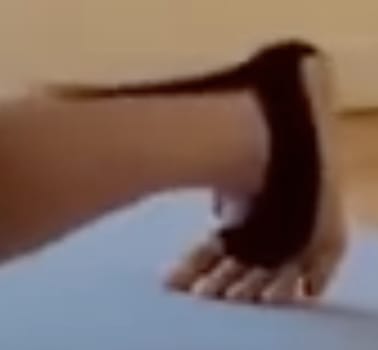
January 26, 2021 -- Annie publishes Legs-up-the-wall-follow-along on her YouTube channel.
⬇️ See dropdown section ⬇️
⬇️ See dropdown section ⬇️
- 14:13 -- Blue medical tape on the inside of Annie's left leg is visible:
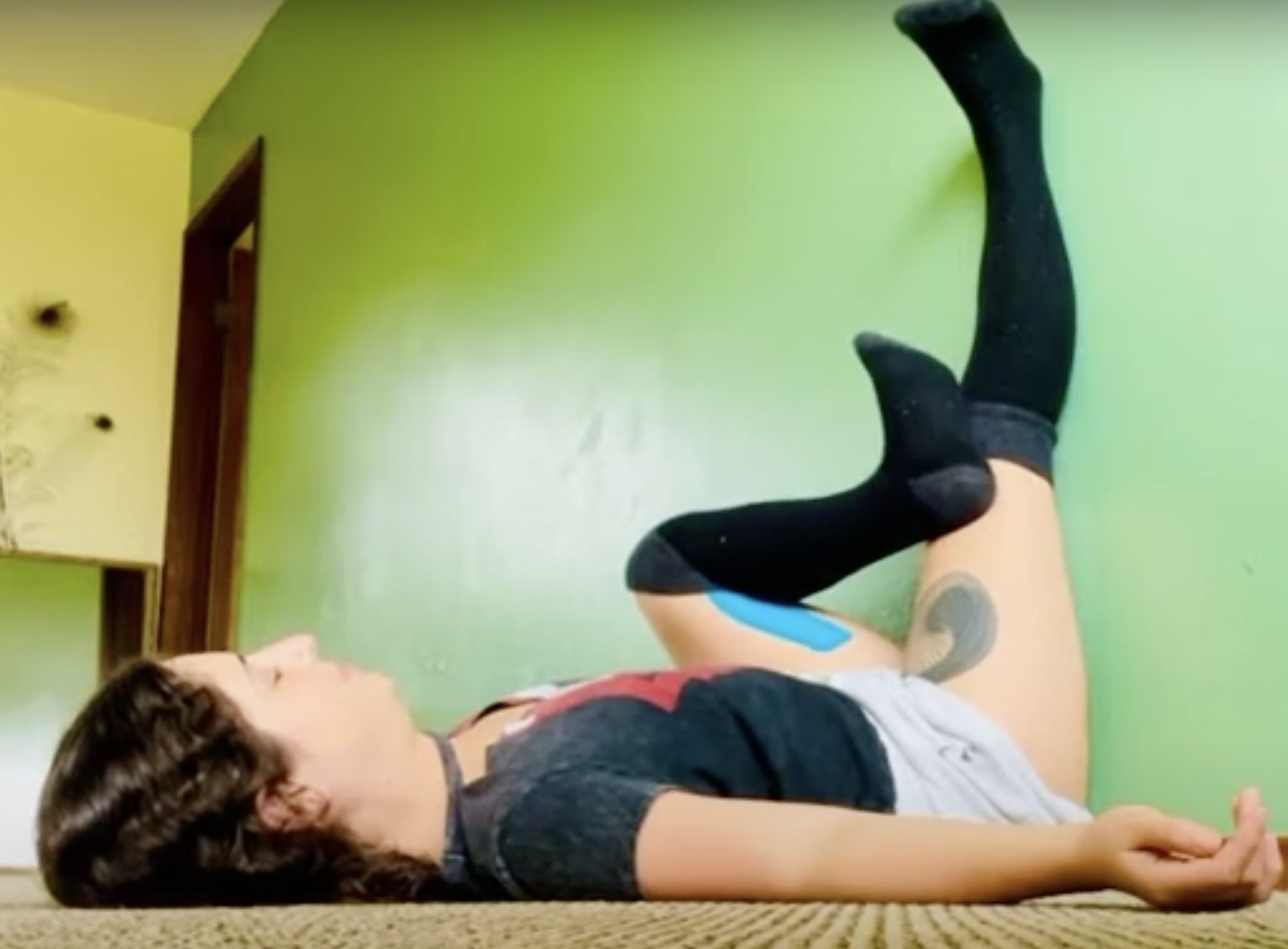
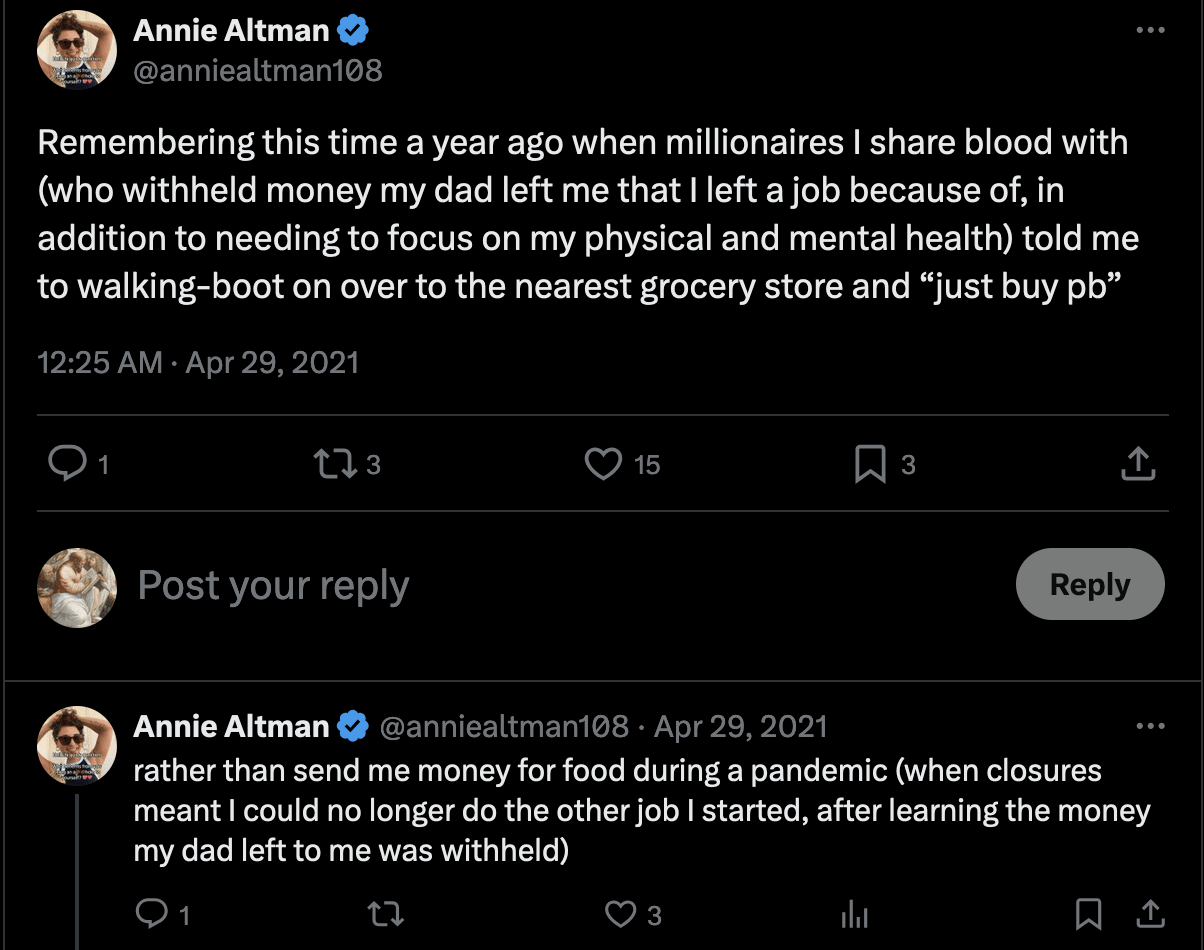
May 4, 2021 -- Annie publishes Yogaish Flowish Rinseish on her YouTube channel.
⬇️ See dropdown section ⬇️
⬇️ See dropdown section ⬇️
- 3:02 -- Black medical tape on Annie's left ankle and foot is visible:

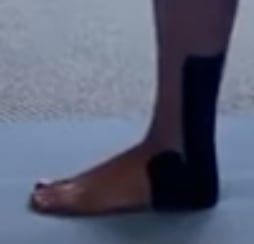
June 7, 2021: Annie publishes "An Open Letter To The EMDR Trauma Therapist Who Fired Me For Doing Sex Work" on her blog. [AA21c]
⬇️ See dropdown section ⬇️
⬇️ See dropdown section ⬇️
- It seems Annie was trying to use EMDR to heal her PTSD, which, as she claims, resulted from having flashbacks to and stronger memories the abuse, e.g. sexual abuse from Sam, that she was subjected to during her childhood.It seems her therapist rejected her as a client on the basis of her position as a sex worker.
July 2021: Sam purchases a $43 million estate in Kailua-Kona, on the Big Island of Hawaii [BI23a].
⬇️ See dropdown section ⬇️
⬇️ See dropdown section ⬇️
- From [BI23a]:
- "Altman's purchase of the Hawaii property has not been previously reported. BI linked the property to Altman by examining business and real-estate filings showing the land was owned by an LLC managed by Jennifer Serralta, whose name appears as a manager on paperwork for other businesses known to be owned by Altman. Serralta, who previously worked in the automotive industry, describes herself on LinkedIn as the chief operating officer of a family office — presumably Altman's — and is his cousin, according to an obituary for their grandmother. Reached by phone, Serralta declined to comment.""In a March post on her personal blog, Serralta wrote that she stayed at a Kailua-Kona property owned by "a friend" while vacationing in Hawaii. Last year, Altman tweeted a photo of himself wakesurfing in Hawaii; the view of the Big Island in the background of the photo precisely matches the view from the Kailua-Kona compound. And in 2021, Altman registered a business, the Sam Altman Qualified Opportunity Fund, at an address adjacent to the property. (It's possible that Altman wanted to register the business to his address but made a mistake; the address he used differs from his own by just one digit and has been owned by the same person since 2007.)"
- Note: Business Insider's statement seems accurate; see my analysis using Google Maps in [BI23a] in the References, and key excerpts from them section of this post.The Tweet that Sam posted:
In late 2021, Sam reaches out to Annie with "seemingly kind words" [AA23m] 1 year after full contact (or, equivalently, 1.5 years after the two family therapy sessions) [AA24k]. Annie writes, "We spoke on the phone three times, and through these conversations I began to suspect the offer was another attempt at control. It seemed I would never have direct ownership of the house. Also, given the nature of my PTSD flashbacks, the house felt like an unsafe place to actually heal my mind and body." [AA23m] Thus, Annie refuses Sam's offer.
Also (as it seems to me), during these phone calls, Annie tells Sam that she is doing sex work, even though she doesn't want to (i.e. she is doing so out of desperation, to survive, while burdened with various illnesses that prevent her from doing a normal job.) Sam responds: "Good." [BB24d]. (Though "A person close to Sam says that Sam remembers the conversation differently." [BB24d].)
⬇️ See dropdown section ⬇️
Also (as it seems to me), during these phone calls, Annie tells Sam that she is doing sex work, even though she doesn't want to (i.e. she is doing so out of desperation, to survive, while burdened with various illnesses that prevent her from doing a normal job.) Sam responds: "Good." [BB24d]. (Though "A person close to Sam says that Sam remembers the conversation differently." [BB24d].)
⬇️ See dropdown section ⬇️
- Annie has stated: "There were other strings attached they made it feel like an unsafe place to actually heal from the experiences I had with him." [AA23g] "The offer was after a year and half no contact {with Sam}, and {I} had started speaking up {about Sam, and his abuse/misconduct} online. I had already started survival sex work. The offer was for the house to be connected with a lawyer, and the last time I had a Sam-lawyer connection I didn’t get to see my Dad’s will for a year." [AA23h]From [BB24d]:
- Ellen Huet: "It's not a clean cut situation. In twenty twenty two, Sam offered to buy Annie a house, but she says it wasn't going to be in her name, and the conditions made her uncomfortable."Annie Altman: "It became clear to me that it was not an offer for my house. It was an offer for a house of Sam's - or a lawyer of his - that I would be allowed to live in."
On November 13, 2021, Annie makes 3 posts (Tweets) to X (Twitter) -- [AA21a] and [AA21b] -- where she publicly states that she "experienced sexual, physical, emotional, verbal, financial, and technological abuse from my biological siblings, mostly Sam Altman and some from Jack Altman".
Annie also states: "I feel strongly that others have also been abused by these perpetrators {i.e. her biological siblings (brothers) Sam, Jack, and Max}."
Annie also states: "I feel strongly that others have also been abused by these perpetrators {i.e. her biological siblings (brothers) Sam, Jack, and Max}."
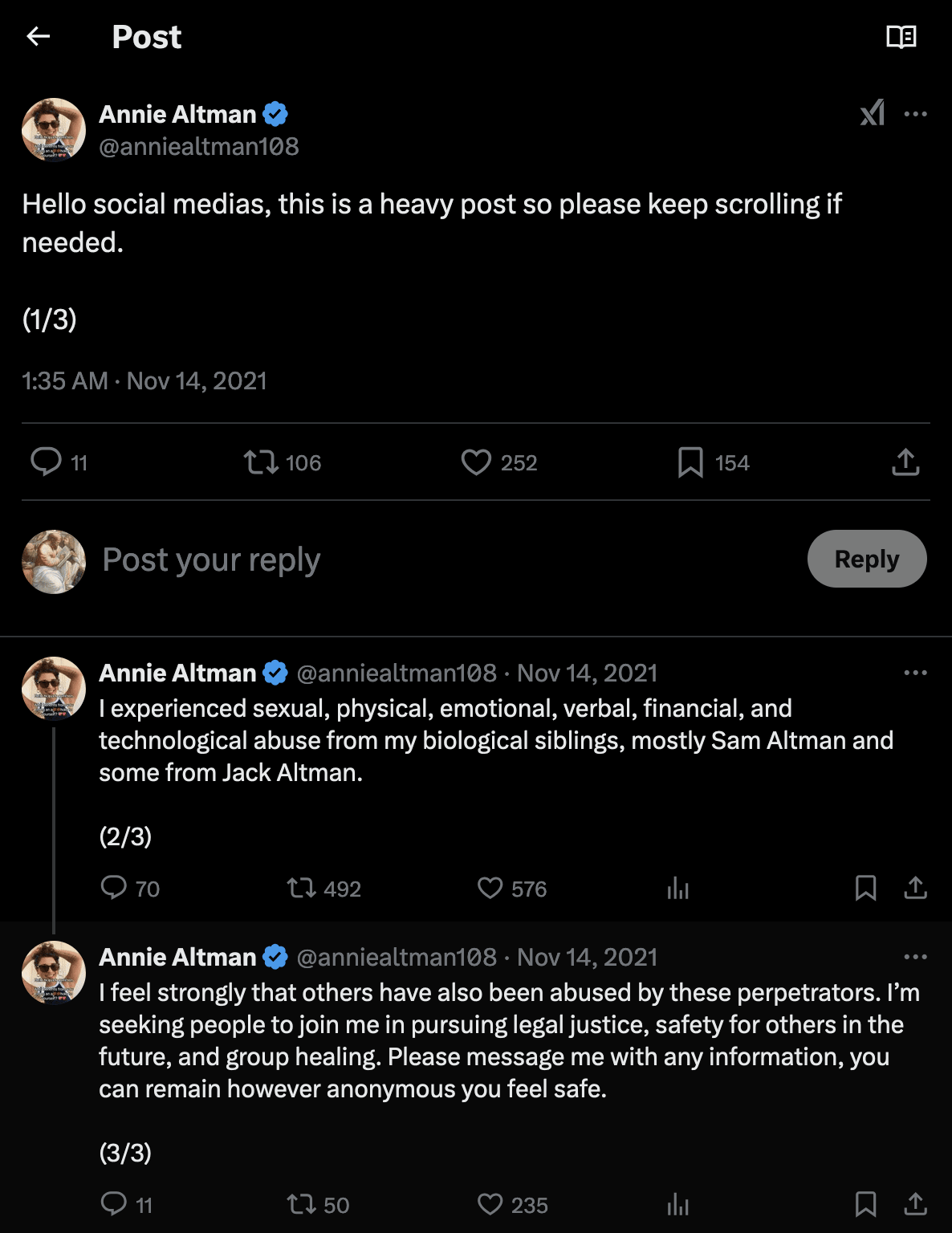
Note: the image above -- where Annie's 3 Tweets have 252, 576, and 235 likes, respectively -- is a screenshot that I took in January 2025.
Per the Tweet shown below, it seems that, prior to early October 2023, Annie's 3 Tweets above had zero likes, retweets, or comments from other accounts (the single comment is just a reply from Annie herself.)
Per the Tweet shown below, it seems that, prior to early October 2023, Annie's 3 Tweets above had zero likes, retweets, or comments from other accounts (the single comment is just a reply from Annie herself.)

Next post
As noted at the beginning of this post, this post is the 4.5th post in a series of 7 posts that are meant to be read in order.
Now that you've read this post, you should read the 4.6th post ("Part 4.6") next:
Sam Altman's sister claims Sam sexually abused her -- Part 4.6: Timeline, continued continued
Discuss


